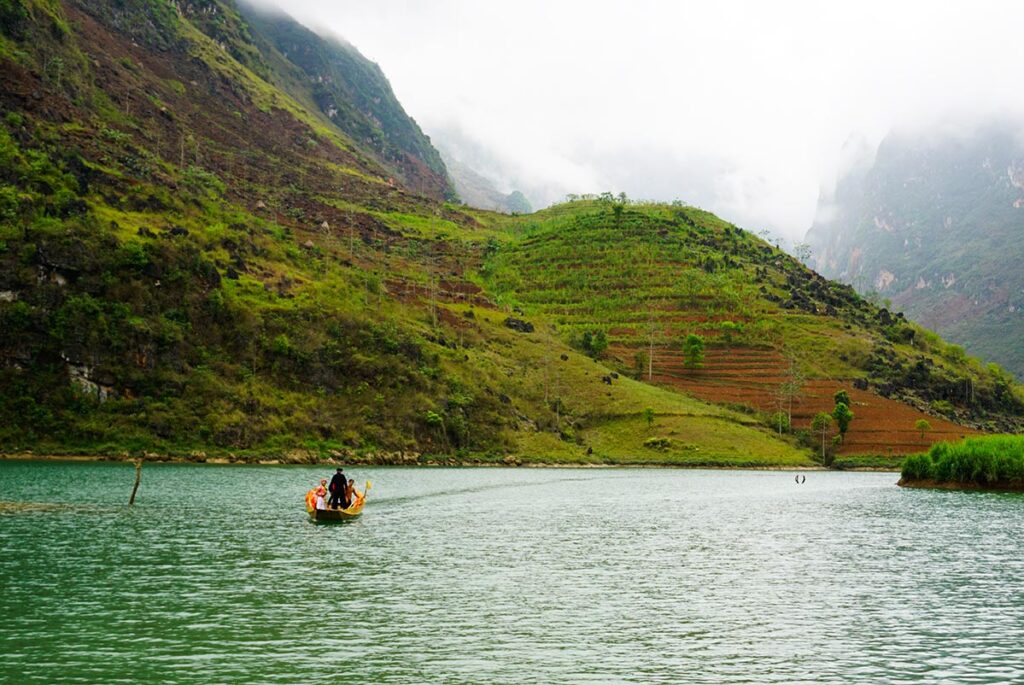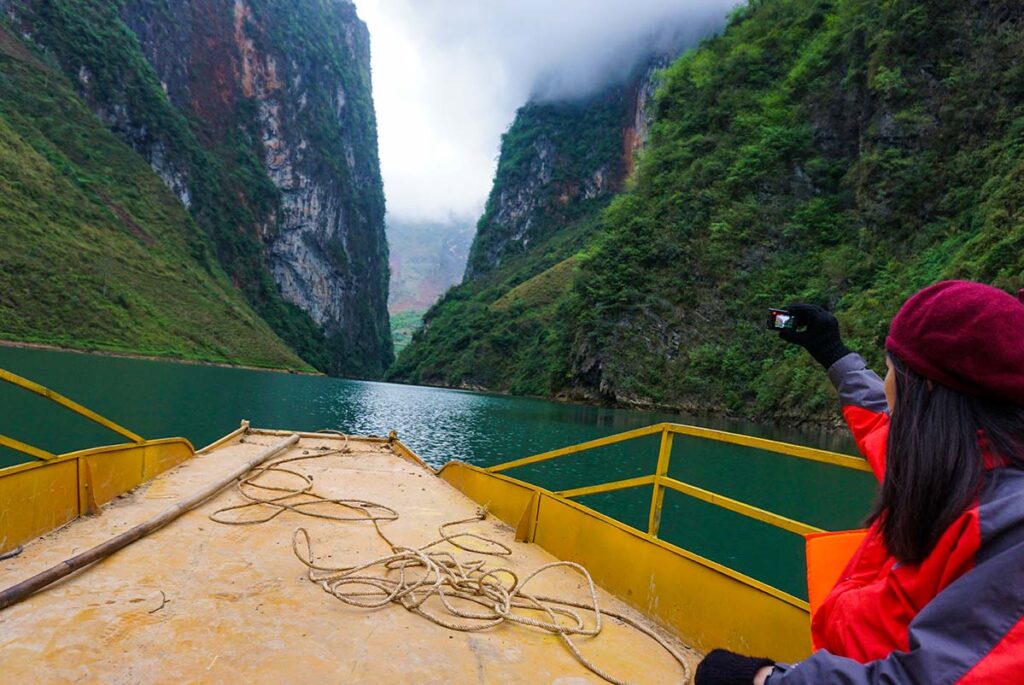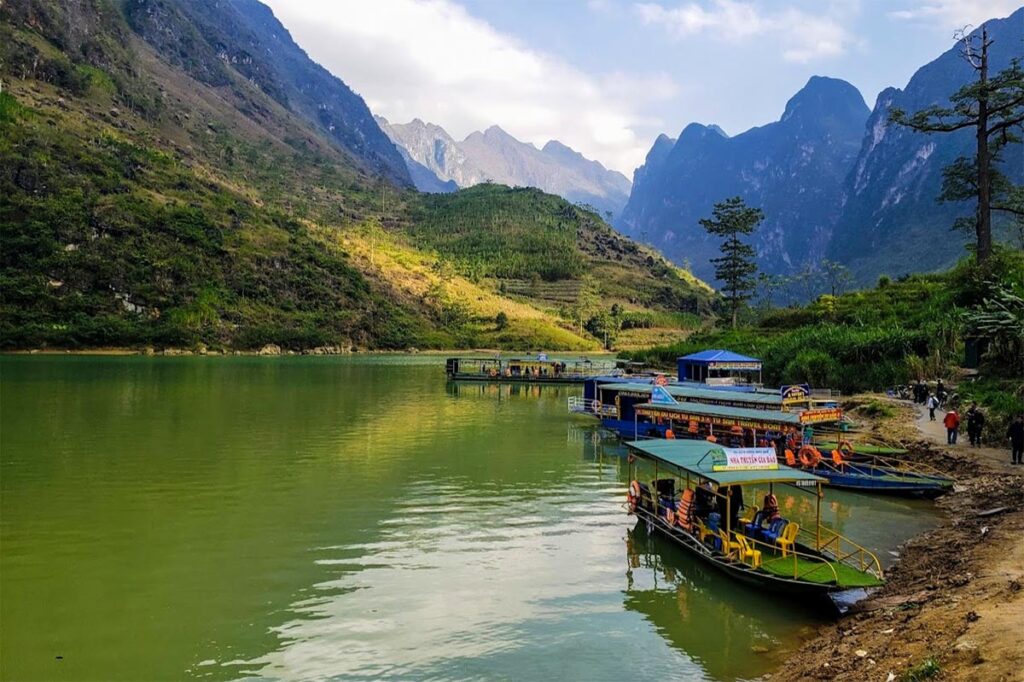About the Nho Que River
The Nho Que River is one of the most stunning natural features in Vietnam’s Ha Giang province, carving a meandering path through majestic limestone mountains and sprawling valleys. Originating in Yunnan Province, China, the river flows through Ha Giang Province, Cao Bang Province, and China for 192 kilometers.

It passes through the Ma Pi Leng Pass, one of the “Four Great Passes” in Vietnam. The river serves as a serene backdrop to several ethnic minority villages in the region and is an integral part of local life, used for fishing, irrigation, and sometimes even transportation.
View from Ma Pi Leng Pass

Ma Pi Leng Pass is cited as the best viewpoint to appreciate the grandeur of the Nho Que River. The pass is part of the famous Ha Giang Loop and is one of Vietnam’s “Four Great Passes.” From the top, you can look down upon the emerald ribbon of the river winding its way through the gorge, flanked by towering limestone cliffs. The area offers multiple lookout points, perfect for photography and soaking in the views. It’s a must-visit spot for anyone traveling through Ha Giang.
Nho Que River boat tour

For those looking to get up close and personal with the river, a boat tour on the Nho Que is an experience not to be missed. The tour gives you a unique perspective of the surrounding natural beauty as you navigate the calm waters. With sheer cliffs rising on either side and the occasional sighting of local fishermen in traditional boats, this is the way to see the Nho Que River from within, as part of the landscape rather than as a distant observer.
Arranging a Nho Que River boat tour
- Boat Trip Cost: Expect to pay around VND 130,000 per person for a boat trip along the Nho Que River.
Wharfs for Access:
- Ta Lang Wharf:
- Location: Situated in Ta Lang Village, Pai Lung Commune, about 4 kilometers from Dong Van.
- Road Condition: The 8-kilometer road to the wharf is bumpy with steep climbs and multiple bends.
- Travel Tips: Check the condition of your motorbike tires if using one; consider a taxi for safer travel.
- Xin Cai Wharf:
- Location: One of the first remote communes in Meo Vac District, visible from the Ma Pi Leng pass area.
- Road Condition: Similar to Ta Lang, the route is challenging but offers stunning views of the river.
Off the beaten Khau Vai

For travelers seeking a less conventional view of the Nho Que River, the area around the district of Khau Vai offers an off-the-beaten-path experience. Unlike the other viewpoints, this spot is not visited by tourists and provides a more secluded atmosphere to enjoy the river’s beauty. To reach this spot, you’ll likely need to do a bit of hiking, but the journey is well worth it.
Tips for seeing the Nho Que River
1. Plan Your Visit During Optimal Weather Conditions
While the Nho Que River is a year-round attraction, it’s best experienced during clear weather. The river looks particularly striking under blue skies, and visibility is often better during the dry season, which runs from October to April.
2. Equip Yourself for Photography
The dramatic vistas of the Nho Que River provide a host of photographic opportunities. Make sure to bring a good camera, along with additional batteries and storage cards. A tripod can be beneficial for capturing long-exposure shots, particularly if you’re touring the river at dawn or dusk.
3. Opt for an Early Morning or Late Afternoon Visit
These times often provide the best light for photography, and the cooler temperatures make for a more enjoyable experience. Plus, there’s a certain magic to seeing the river enveloped in the soft glow of the morning or late afternoon sun.
4. Wear Comfortable Footwear
Whether you’re navigating the Ma Pi Leng Pass or trekking to more secluded viewpoints, sturdy and comfortable footwear is a must. The terrain can be rugged, and you’ll want to be prepared for some walking.
5. Consider a Local Guide
While many of the river’s viewpoints are easily accessible, hiring a local guide can enrich your experience. They can provide insights into the best times to visit certain spots, interesting facts about the river, and even introduce you to lesser-known viewing locations.

